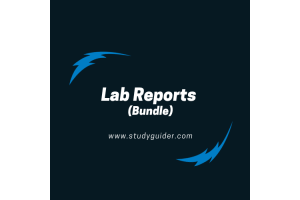BIOL202 Week 3 Lab 3 Culturing and Aseptic Technique
- $20.00
Lab 3: Culturing and Aseptic Technique (100 points)
- Each question on the lab worksheet must be answered completely, thoroughly, in complete sentences and correctly in order to be considered for full credit
- If the question asks you to do research or find a source, a reputable, credible and/or scholarly source citation must be included in order to be considered for full credit
- If a math formula is required to arrive to an answer, work must be shown otherwise, no credit will be awarded
Pre-Lab Questions
- Proper aseptic technique is crucial to ensuring growth of pure bacterial colonies. What is the experimental way you can test your practices to confirm that you are using proper aseptic technique? (5 points)
- In a laboratory setting, what are three ways you can properly sterilize culturing equipment? (5 points)
- For each inoculation tool, give one scenario in which use of that tool would be appropriate. (5 points)
Experiment 1 Results Tables
Experiment 1 Post-Lab Questions
- Do some research and try to identify one to three types of microbes cultured on your plates. Using any resources available to you (i.e., a textbook or internet sources such as the CDC website), look up what bacteria are usually found on the areas from which you obtained your samples and the morphological characteristics of their colonies. Describe what morphological traits (i.e., size, shape, arrangement, color, margin, etc.) led to your hypothesized species identification. Be as specific as possible in the microbe type. (5 points)
- For the colonies hypothesized in Question 1, specify which plate and source the microbes came from. Are you surprised to find this type of microbe on this surface? (5 points)
- Looking at your negative control, did you perform proper aseptic technique or were your plates contaminated? If contamination did occur, list the possible sources and how you can prevent contamination in the future. (5 points)
- Was there a large risk for airborne contamination of your experimental plates (look at your airborne control plate)? Based on the colonies that grew on your plates, do you think any of your experiment plates received airborne contamination? (5 points)
Experiment 2 Results Tables
- Table 2: Initial Reserved Plate Colony Growth Observations (15 points)
- Table 3: Final Plate and Stab Tube Growth Observations (15 points)
Experiment 2 Post-Lab Questions
- Were all of your colony transfers successful? Explain what could have been the cause of any unsuccessful transfers. (5 points)
- Did you have any growth that was different in appearance from the initial plates? What might account for any differences in growth on the transfer plate/tube? (5 points)
- Describe why an unsuccessful transfer or growth of the transfer plate/tube differing from the initial plates would be a problem if this experiment were placed in a larger context (i.e., only one step in a longer experiment). (5 points)
- Do some research and describe two or three scenarios in which it would be preferable to use a stab tube vs. a growth plate. (Hint: What do bacteria use to help them move? Can motility be used to help identify many medically important pathogenic bacteria such as the Enterobacteriaceae?) (5 points)




































